
Loess mantles cover about 6% of the total area of China, covering a large area of the northern and central part of the country, forming a spectacular landscape known as the Loess Plateau. The uniqueness of loess lies in its meta-stable soil structure (which was introduced in this previous Science Trends article). It is problematic upon wetting as it can rapidly transform a somewhat intact slope into a fluidized landslide with long-traveling distance and far-reaching impact. The study of loess is of direct interest to the well-being of the inhabitants in the loess-mantled area. Research on loess landslide in China sustained its popularity for many decades due to significant societal impact.
In the past two years, a collaborative research team from the State Key Laboratory of Geohazard Prevention and Geoenvironment Protection (SKLGP) at the Chengdu University of Technology and the Sustainable Geotechnical Systems Laboratory (SGSL) at the Georgia Institute of Technology, investigated 69 loess landslides distributed on the margin of the Heifangtai terrace (area: 12 km2) located in Gansu Province, northwestern China. The terrace has a loess cover of 26 – 48 m and the retrogressive nature of many loess landslides in Heifangtai (i.e. new landslide developed at the same location of the preceding failure) is depleting the terrace at an average rate of 0.024 km2 per year.
In the 1960s, construction of a hydropower station located downstream of Heifangtai resulted in the current local residents to settle in the area, which led to the vast growth of agricultural activities on the surface of the terrace. Irrigation has increased the groundwater level by 20 m at an average rate of 0.18 m per year. Evidence of ground subsidence (> 1 m) were found in the early 1980s with incipient failures developing along the edge of the terrace (Derbyshire, 2001; Derbyshire et al., 1995). Since then, about 200 landslides have been reported, with many developed behind the same scarp of the previous failure. They have caused severe impacts to the life of the locals; 37 people were killed and more than 100 were injured, with direct economic loss exceeding 25 million USD (Chen et al., 2011).
The high frequency of landslide is directly related to irrigation. Our team mapped all the current landslides, implemented monitoring devices for slope displacement and groundwater level changes in the field, and sampled and tested engineering properties of loess. We classified loess-related landslide types in Heifangtai because in many cases, the landslide classification system enables us to establish a ‘baseline’ of the problem as it can reflect the landslide material and behavior. Peng et al. (2017) defined loess-related landslides in Heifangtai into 5 types and incorporated them in the well-known Varnes classification framework (Hungr et al., 2014; Varnes, 1978) to provide backward compatibility for landslide research in other regions in the Loess Plateau. We found that the difference between the direction of the slope deformation and the bedrock dip governs the landslide types, and in turn, the size, volume, and mobility of the potential landslides.
We analyzed and revealed the failure process a particularly disruptive type of loess landslide, classified as loess flowslide, which is characterized by its abrupt deformation, fluidized movement with high-speed and long-runout, and retrogressive failure pattern. Qi et al. (2017) proposed a failure mechanism for flowslide involving a two-stepped process based on the interplay between groundwater movement behind the slope and loess structure.
The proposed mechanism applied the concept of soil liquefaction (a phenomenon describes the losses of strength and stiffness in response to a change of stress condition) to explain the abrupt deformation of loess flowslides. The groundwater behind the slope disaggregates the loess fabric, which reduces pore size in loess and affects pore distribution by filling the voids; accompanied by strain-softening, void ratio reduction and rising pore-water pressure can change the loess element from a stable state to a mobile system with high liquefaction potential. With the increasing groundwater level due to irrigation and very nature of the loess-water interaction, landslide in Heifangtai will likely to be intensified as irrigation continues.
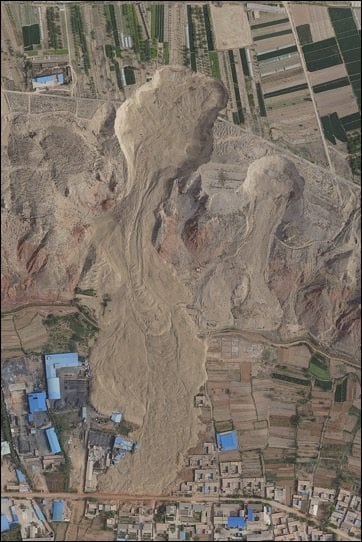
Oblique aerial photos of DC2# loess flowslide occurred on April 29,2015, in Heifangtai. Credit: Fangzhou Liu
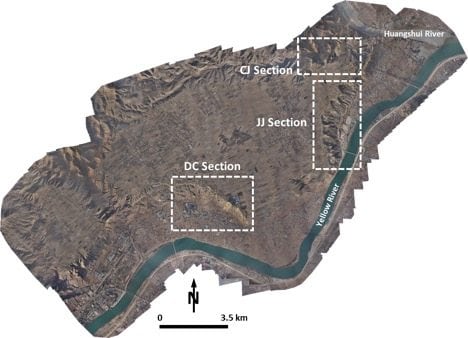
Landslide distribution of Heifangtai. Aerial images of landslides in DC, CJ, and JJ sections are shown. Credit: Fangzhou Liu
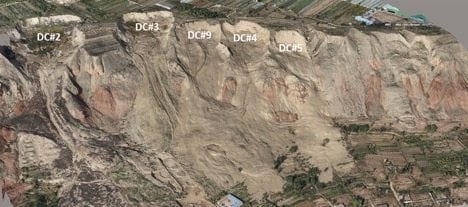
Aerial image of the DC#2 flowslide and other flowslides in the DC section of the terrace, including the most recent flowslides, DC#4, DC#5, and DC#9, occurred 5:00-7:00 AM on Oct 1, 2017. Our field monitoring system sent an early warning to the local government which ensured timely evacuation of the downstream village. Credit: Fangzhou Liu
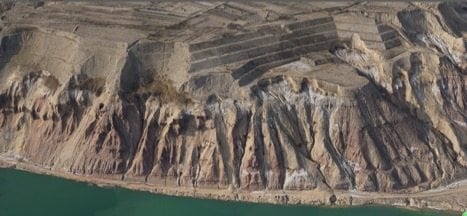
Loess flows in JJ section. Credit: Fangzhou Liu
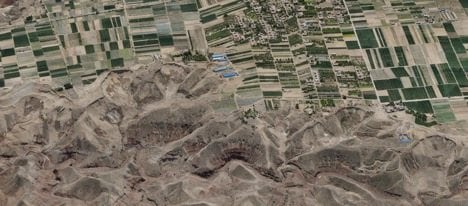
Loess flowslides in CJ section. Credit: Fangzhou Liu
This article was contributed by Dr. Qiang Xu, the deputy director of the SKLGP at the Chengdu University of Technology and Fangzhou Liu from the SGSL at the Georgia Institute of Technology.
Dr. Xu and Liu published their recent studies, ‘Distribution and failure modes of the landslides in Heitai terrace, China’ and ‘Analysis of retrogressive loess flowslides in Heifangtai, China’, on Engineering Geology. Recent findings were also featured in the Landslide Blog by Dr. Dave Petley.
References
- Chen, C., Xing, X., Li, P., Li, T., 2011. Analysis of loess slope stability of Heifangtai, Gansu Province. J. Eng. Geol. 19, 550–554 (in Chinese).
- Derbyshire, E., 2001. Geological hazards in loess terrain, with particular reference to the loess regions of China. Earth-Science Rev. 54, 231–260. doi:10.1016/S0012-8252(01)00050-2
- Derbyshire, E., Meng, X., Wang, J., Zhou, Z., Li., B., 1995. Collapsible loess on the loess plateau of China, in: Genesis and Properties of Collapsible Soils. Springer Netherlands, pp. 267–293.
- Hungr, O., Leroueil, S., Picarelli, L., 2014. The Varnes classification of landslide types, an update. Landslides 11, 167–194. doi:10.1007/s10346-013-0436-y
- Peng, D., Xu, Q., Liu, F., He, Y., Zhang, S., Qi, X., Zhao, K., Zhang, X., 2017. Distribution and failure modes of the landslides in Heitai terrace, China. Eng. Geol. doi:10.1016/j.enggeo.2017.09.016
- Qi, X., Xu, Q., Liu, F., 2017. Analysis of retrogressive loess flowslides in Heifangtai, China. Eng. Geol. 0–1. doi:10.1016/j.enggeo.2017.08.028
- Varnes, D.J., 1978. Slope movement types and processes, in Schuster, R.L., and Krizek, R.J.,eds., Landslides – Analysis and control. Natl. Acad. Sci. Transp. Res. Board Spec. Rep. 176, 11–33. doi: In Special report 176: Landslides: Analysis and Control, Transportation Research Board, Washington, D.C.









